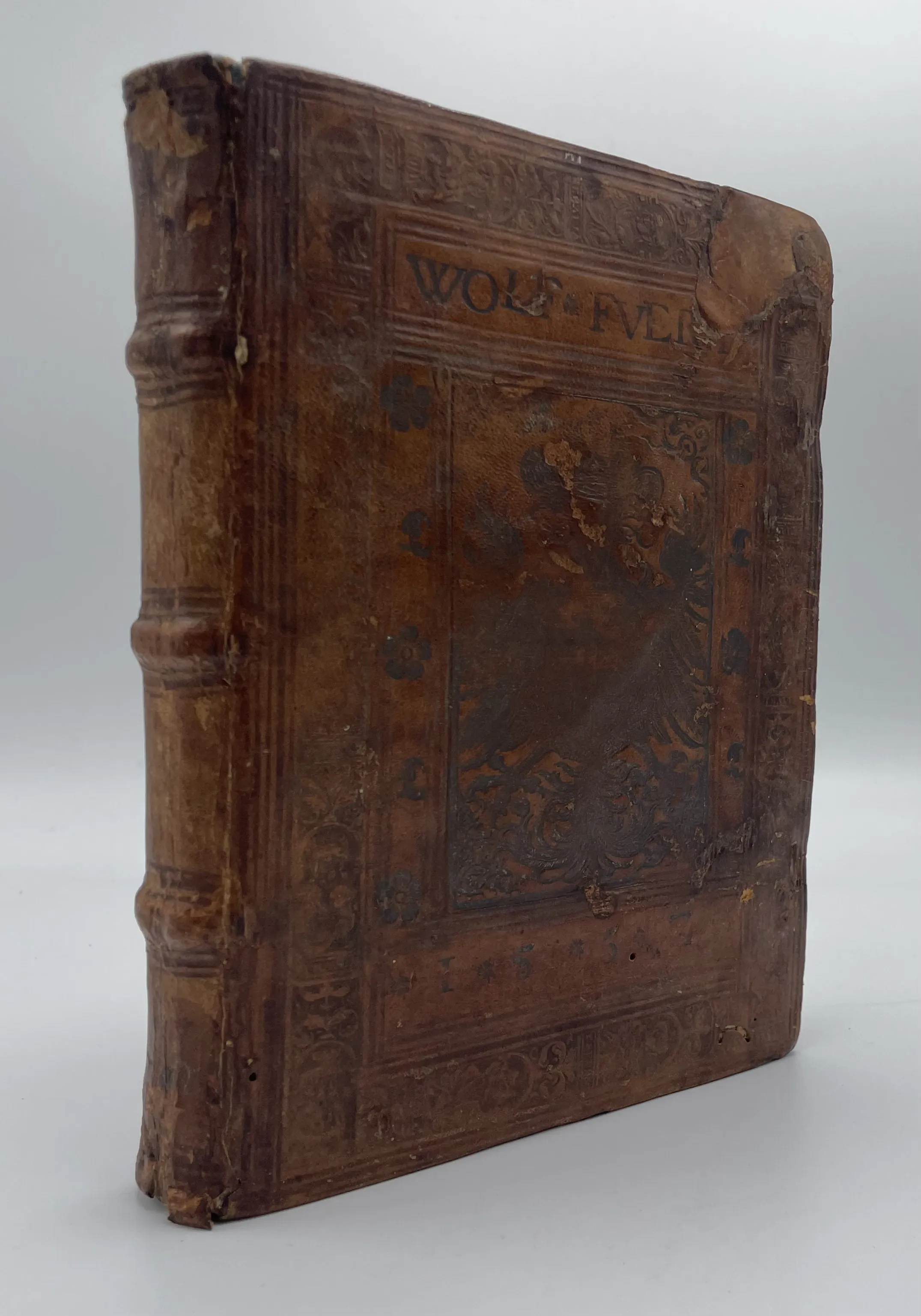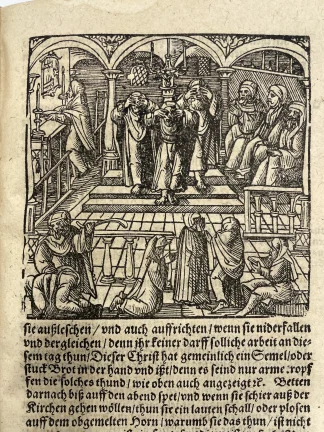WEIDNER, Paul; MARGARITHA, Anton.
Ein Sermon... (with) Der gantz Judisch Glaub
(1) Vienna, (2) Frankfurt-am-Main, (1) Raphael Hoffhalter, (2) n.p., (1) 1562, (2) 1561.£9,500.00
(1) FIRST EDITION. 4to. ff. 132. Gothic letter, title in red and black, sporadic Hebrew. Final errata, large pictorial woodcut to final leaf. Long marginal ms. note to N4. Large initials and printed marginalia throughout, some marginal worm holes not affecting text. (with…)
(2) 4to. Ff. 116. Gothic letter, large initials, printed marginalia. Woodcut to t-p of two Jewish men disputing and 3 more depicting Jewish customs and places of worship, light age browning.
Good, clean copies, the second slightly age browned, in contemporary panelled calf with decorated tool rolls with portraits of the god Apollo and the Muses on the outer frame and blind stamped flowers surrounding a central panel, containing imperial arms on upper cover, with ‘WOLF FVER(T?)’ above and date 1537 below, and ornate floral arabesque pattern in rectangular frame to lower. Early repairs to covers, some cracking to edges and spine, later eps, recased.
A fascinating pair of works relating to Christian views of the Jewish community at the time of the Reformation, written by two Christian converts, the latter influenced the writings of Martin Luther (1483-1546). The first work records a Christian Sermon delivered by Paul Weidner (1525-85) at a Synagogue in Prague on the 26th of April 1561. Weidner was born Nathan Ashkenazi but converted to Christianity in 1558. He studied medicine at the university of Padua and practised for a time in Udine, before returning to his native Carinthia, an Alpine region of Austria. He left for Vienna after a six year stay, where he converted a year later. Weidner became a member of the royal court, serving as a personal physician to the Austrian emperors and was even granted the responsibility of scrutinising books confiscated by Ferdinand I from the Bohemian Jewry. He also taught Hebrew at the university of Vienna and obtained Imperial permission to preach to Jews with the intention of converting them to Christianity. His other published works were similarly aimed at convincing the Jewish people of the truth of Christianity.
The second work is a later edition of Anton Margharita’s (born c.1490)) Jewish encyclopaedia, which was the first German text to depict their customs, ceremonies and prayers. The work controversially compared these with Christian liturgy, in an attempt to reveal their falsehood. ‘The author ridicules Jewish ceremonies, accuses Jews of usury and of sentiments hostile to Christians and Christianity, and argues against Messianic hopes’. Furthermore, he provides anecdotal evidence for his attacks, as he was the son of Samuel Margolis, the chief rabbi of Regensburg and was raised as a Jew, before converting to Catholicism in 1522 at Wasserburg am Inn. Despite the author’s imprisonment and banishment from Augsburg, the text was hugely widespread and Martin Luther’s 1543 work ‘On Jews and their lives’, quotes Margharita often.
The woodcut on the t-p is a simplification of the 1530 edition, which comprised a more complex multifigured scene, attributed to Jorg Breu the Elder (1475-1537), but the essence of the dispute and the poses of the two men remain largely the same. The rest of the woodcuts are reduced in number from 3 to 6, but the series still follows those of Johann Pfefferkorn (1469-1523), who published his own antisemitic title in 1508.
USTC: 647081, 633355; Steinschneider: 1676; Adams: M 574; BM Cat. (Germany): p.594, p.908; Jewish Encyclopedia (https://jewishencyclopedia.com/articles/10404-margarita-antonius).








